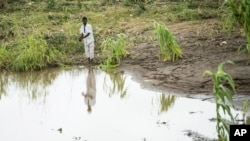Malawi, which already is suffering from food shortages, this week banned the import of unmilled maize from Kenya and Tanzania over concerns that the spread of maize lethal necrosis disease could wipe out the staple food.
The ministry of agriculture announced the ban in a statement that said the disease has no treatment and can cause up to 100% yield loss. The statement said maize can be imported only after it is milled, either as flour or grit.
Henry Kamkwamba, an agriculture expert with the International Food Policy Research Institute, told VOA that if the disease were introduced into the country, it would be difficult to contain.
He used the banana bunchy top virus as an example of the potential danger.
“Think of how we lost all of our traditional bananas in the past and now Malawi is a net importer of bananas ... due to our lax policies in terms of imports,” he said.
“There are these similar concerns with maize,” he said, with maize being the nation’s main food crop.
Kamkwamba predicted the ban would help Malawi prevent the disease from spreading.
Kenya and Tanzania have long been primary sources of maize for Malawi during periods of food shortage.
Malawi is facing shortages largely because Cyclone Freddy destroyed thousands of hectares of maize last March.
The World Food Program in Malawi and the Malawi Vulnerability Assessment Committee estimate that 4.4 million people — around a quarter of the population — would face food shortages until March 2024.
Grace Mijiga Mhango, the president of the Grain Traders Association of Malawi, said that while she understands the severity of the impact of the maize disease, banning imports at a time of need would likely result in higher costs.
“If we really don't have enough food, then we are creating another unnecessary maize [price] increase,” she said.
The next alternative for maize imports is South Africa, she said.
“South Africa is quite a distance,” she said, “and they don’t have enough. … It will be expensive.”
Malawi’s government said the ban will be temporary as it explores other preventive measures to combat the spread of maize lethal necrosis disease.









